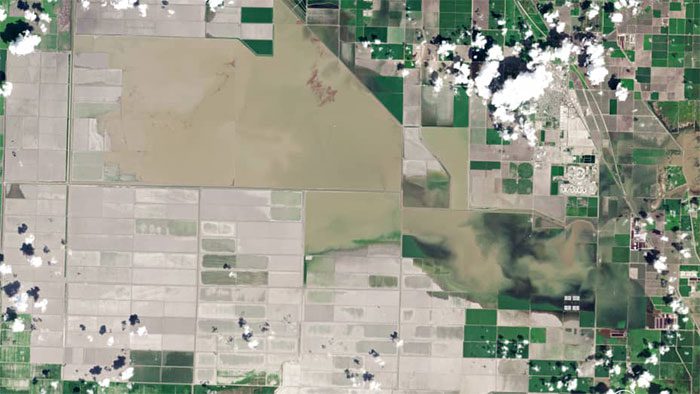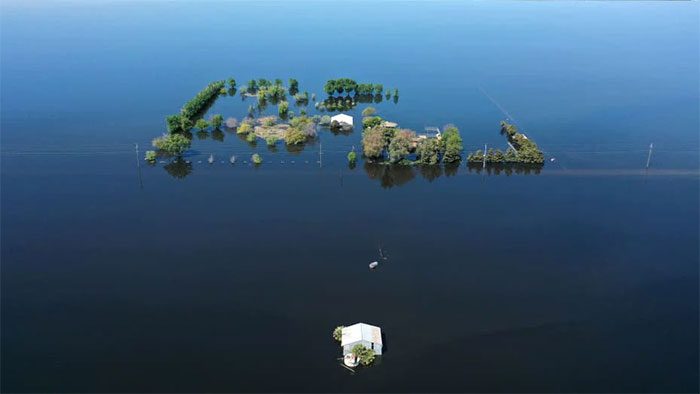Recent satellite images reveal a powerful resurgence of Tulare Lake in California, USA.
The Return of the Ghost Lake
Recent satellite images show a strong revival of Tulare Lake in California’s Central Valley, predicting that flooding may persist for the next two years in this arid agricultural land.
Although Tulare Lake is typically dry, it occasionally reappears due to flooding, especially during periods of unusual heavy rainfall, earning it the nickname “ghost lake.”
Images from Planet Labs illustrate the transformation from a parched basin to a vast, deep lake stretching approximately 10 miles from one shore to the other in an area once used for growing almonds, tomatoes, cotton, and other crops.

Satellite image shows the emergence of the ghost lake. (Photo: Planet Labs).
Scientists warn that flooding will worsen as the historically massive snowpack in the Sierra Nevada mountains melts, adding more water to the basin. Last month, a heatwave caused widespread snowmelt in the mountains, threatening small farming communities grappling with the resurgence of Tulare’s ghost lake.
The water in the lake could cause billions of dollars in economic damage, forcing thousands of farmers and residents in agricultural communities to evacuate. Continued flooding also threatens levees, dams, and other vulnerable flood infrastructure in the region.
Tulare Lake was the largest freshwater body west of the Mississippi River until the late 1800s when its tributaries were diverted for agricultural irrigation and urban water use. As lake levels rise, farmers are concerned about losing their entire harvests and having their homes flooded.
For instance, the town of Corcoran in the Central Valley has an earthen levee at risk of breaching due to rising waters and has requested emergency federal funding to raise the levee by several feet.
Stretching over 23 kilometers, this flood protection levee stands more than 57 meters tall. However, in March, the water level of Tulare Lake rose to nearly 54.2 meters.
“The Corcoran community has only a short window of dry conditions before the melting snow from the Sierra Nevada mountains merges with the existing floodwaters in Tulare Lake, threatening the Corcoran levee,” authorities warned in April.
Severe Damage
Governor Gavin Newsom visited Corcoran this week to assess flood damage, stating that the worst is yet to come as the basin continues to receive more water daily. There could be additional water flowing into the basin over the next 16 weeks.
Newsom said: “We are working with federal and local partners to provide on-the-ground assistance and support that local residents need. This weather change is a testament to the climate crisis.”
Karla Nemeth, director of the California Department of Water Resources, noted that the last major flooding in the basin occurred in the 1980s and took about two years for the water to evaporate or be pumped out. She mentioned that the department is devising plans to redirect water before it reaches the lake basin.
More than 600 structures in Tulare County have been damaged by flooding, according to officials, and the damage from the floods is still being assessed. Thousands of cattle have gone missing due to the floods, while approximately 75,000 have been relocated to safety. The flooding has also washed away essential crops, leaving agricultural workers jobless across the inundated valley.

As lake levels rise, farmers are worried about losing their entire harvest. (Photo: Getty).
Governor Newsom’s office estimated agricultural losses at $60 million due to flooding in crop fields. Potential solutions include installing equipment to pump water back into depleted aquifers that have been overdrawn after years of drought.
According to the governor’s office, the state is providing shelter assistance for displaced residents and supplying flood-prevention materials, including sandbags, barricades, and rocks and sand for levee and riverbank reinforcement.
California is experiencing an unusual rainy season after two decades of drought. A series of atmospheric river events this year has led to near-record snow and rainfall amounts in many areas of the state.
A research team at the Scripps Institution of Oceanography at UC San Diego has found that climate change is increasing atmospheric river storms and could raise flood damage costs from $1 billion annually to over $3 billion annually by the end of this century.


















































